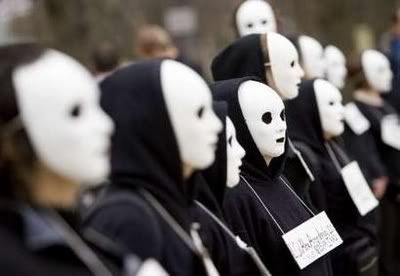An icon that is growing in cultural eminence is the “Guy
Fawkes” mask that was brought to mainstream focus through the film V for Vendetta created by the Wachowski
brothers. Through its association with
the spirit of revolt, the icon has come to embody ideals such as justice,
rebellion, and political keenness within whichever person deciding to wear it.
As of recent, movements with significant influence including Occupy Wall Street
and the “hacktivist” group Anonymous have used the symbol heavily within the
rhetoric. It functions to provide a sense of unity across many elusive,
dissenting claims. It is used as visual rhetoric to signify to others the
spirit a person is trying to convey. With the right precision, the use of this
mask can be surprisingly effective in creating a fairly distinct message.
An example of the precise use of the mask is in the scene of
this picture. Polish senators are seen holding up the emphatic mask to their
faces for what purpose? To protest. They use the symbol behind the mask to
protest the ACTA (Anti-Counterfeiting Trade Agreement) from getting passed
through their political system. The Trade Agreement would impose harsh restrictions
on the liberal use of copyrighted material which is seen by many as a direct
violation of Internet freedom and creativity. The climate that ACTA would
create is the type of climate that the ideology behind the mask is opposed to.
The politicians recognizing this, utilized its symbolism to visually argue the
agreement in a poignant way. This is a testament to the power that a simple
image can hold rhetorically. I believe that this group of politicians’ decision
to use the mask is stronger by leaps and bounds than just simple verbal
argumentation alone. This act would have a far greater reaction with the public
which potentially increases the success and recognition of the argument. All of
the mask’s hype and success reveals the importance of visual rhetoric in modern
culture and it also suggests its potential to cause effect.
Another interesting piece of visual rhetoric using masks is used in the "March of the Dead" in which protesters wear a mask that shows their lack of identity and name of a specific American or Iraqi that was killed in the conflict.


Connor, those masks are kind of spooky! But in all seriousness, they're intriguing rhetorical arguments. I wonder, though, if their rhetorical power is lessened by their connection to the movie V for Vendetta. The masks might seem like a pop-culture fad, not a defiant political statement. Some people might even see the masks as childish or immature, not as modes of personal expression. I suppose the success of these masks relies heavily on the rhetorical audience. If the audience is familiar with the movie and interprets the masks as clever arguments, not hokey ploys, then the masks can succeed. But it seems to me that many audiences likely wouldn't respond so well...
ReplyDeleteHi Connor. I think its cool that people are taking a stand and expressing themselves in a way that isn't too extreme. I never really heard about this so thanks for introducing me to something neW!
ReplyDelete